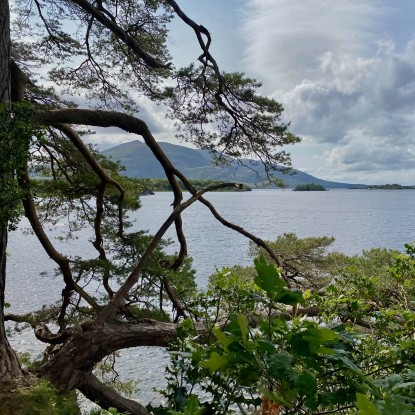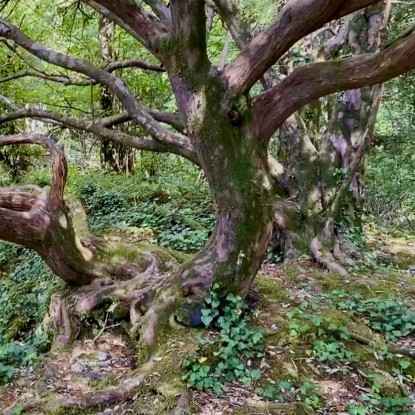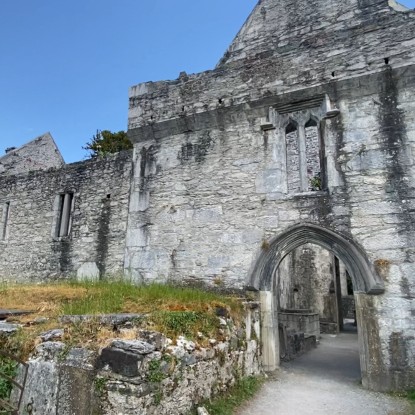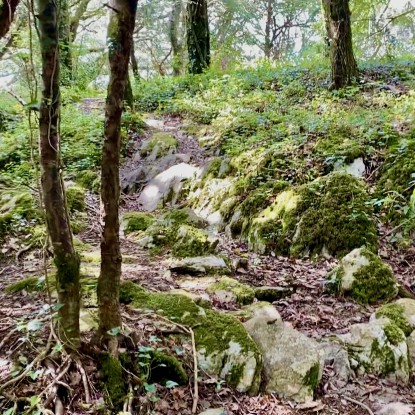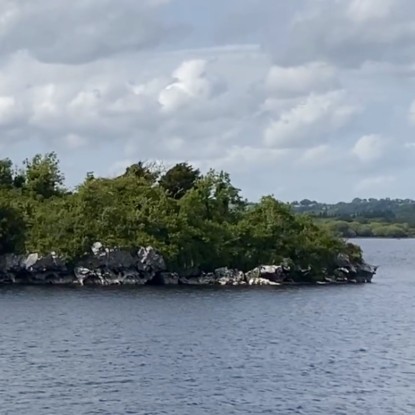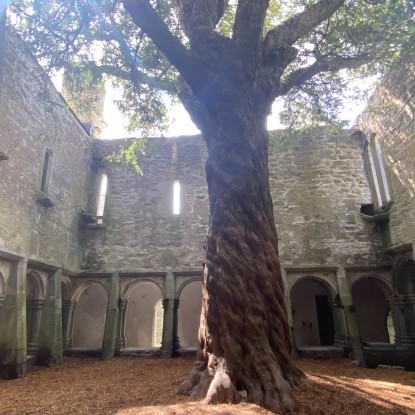A Writer Looking for the Fantastic in Killarney National Park: Field Worldbuilding
Have you ever found yourself walking through your house, between classes, or driving to school or work with nothing playing in your head? That feeling you get when one moment, you’re leaving your room or the house, and the next, you have arrived at your destination with little lucid thought in between. It is as if the world blurs out while leaving just enough awareness for you to not find your face against an unfamiliar surface, be it the floor or some wall. The environment you moved through while in that liminal space used to be new to you, at some point, and now it’s a train track from point A to point B with a lot of set dressing in between.
Now take that feeling and apply it to everything immediately around you. Your town, your county, your state, your country—now you’re Belle singing that you want adventure in the great wide somewhere. It’s why we go abroad. Humans need stimulation; we need to feel something new. And when the area around you feels liminal, it’s very hard to find something fantastic. It’s why we flock to Middle Earth or a galaxy far, far away in our spare time. Why we long to find a special wardrobe in our uncle’s attic or to have a mad man in a blue box take us through time and space. We need to escape to something new, to be rescued by something fantastic.
“I see the title, Jaskier. How does this all relate to worldbuilding?” I hear you ask. Well, my dear reader, it is quite simple: I wanted this blog to act as a field guide to my fantasy writing process while abroad in hopes I could help some fellow writers. I prompt you to put yourself out of your normal everyday environment, go somewhere new, and observe with new eyes. It doesn’t even have to be another country! It’s easier said than done, I will admit. But once you’re somewhere, anywhere new, you will find yourself more in tune with your environment. Then, I challenge you to reframe your thinking, to think in reverse. Once you reframe your thinking and look with new eyes, you can find the root of what you are looking at and use your imagination to create a new branch into a different reality. If you come into a new space looking for something fantastic, you are guaranteed to find it.
Killarney National Park:
When I was a child, in the back left corner of my backyard, there was a big tree with a disc swing. It was placed so perfectly, 7 feet away from the fence, that it created enough shade and isolation from the rest of the yards to block grass from growing and significantly darken the area. Growing up in the suburbs of Chicago, we didn’t have too many trees, which is why, as a child, the 8 square-foot area felt as close to a forest as my sister and I could get without traveling to a literal forest preserve. Even still, the local forest preserve was sparse, and the trees were relatively short, nothing like the forests we saw in movies. Up until I moved to PA, the thickest forest I had been to was an outdoor education campus that local schools sent their kids to in order to learn about the type of nature we didn’t typically have in the north of Illinois. Point in case being: thick forests were always ‘exotic’ to me, for lack of a better word. They were a rare treat. And as a child growing up with a love of fantasy, in my mind, I decided that the little corner of our backyard under our tree was Narnia, and that with my pink and purple Nerf Rebel bow and arrow, I was Susan Pevensie, and my sister was Lucy. To get to Narnia, rather than going through a wardrobe, we had to jump off the swing. I don’t know how we came to that set of conclusions, but we did. That child-like mindset is very important when you’re looking to use nature as inspiration for worldbuilding.
On the second-to-last day before I left Ireland, I went to Killarney National Park, something I had been looking forward to the entire time I was there. What makes this park so special, you may ask? Firstly, it’s got lots of moss, and if you’re anything like me, you are a moss enthusiast. Secondly, and much more importantly, I have pictures of it on the Pinterest boards for my novel, both of the forests and a place called Muckross Abbey. I’m a very visual person. I write cinematically, and every writing project eventually gets its own Pinterest board, if the board wasn’t already step 1. For my fae-inspired high-fantasy, it was. While I couldn’t find all the locations I had seen on Pinterest and Google, I still gained plenty of inspiration. Even if I don’t use everything, the thought exercise was invaluable.
Muckross Abbey:
Before I went on the forest trail, I went to Muckross Abbey, which is a 15th-century church and a modern cemetery. It was estimated to have been founded in the 1440s and was abandoned in the 1650s when the Cromwellian invasion from England pushed the monks out. Since then, it has fallen into ruins. The church itself is, of course, beautiful, but the main attraction is the yew tree planted in its courtyard. The tree is estimated to be as old as the abbey itself, and thought by some to be the oldest in Ireland. However, that title most likely belongs to another tree at Maynooth University, where I was staying. When I arrived, I sat down on the half walls separating the hall from the ground the tree was on, and sat in silence, drinking in the awe I felt. The twists on it are so whimsical and magical, and it's no wonder there are so many legends surrounding it.
The Muckross Abbey yew tree is one of the pictures I had saved on my board. What made it so interesting to me in the first place was the implications of its placement. I found the worldbuilding possibilities endless. The tree’s actual history is mysterious and surrounded by various legends, but for the sake of the thought experiments, it’s best to look at the tree as a blank slate. It is not the actual tree we are theorizing about; it is what something similar could be for you in another world of your creation.
Note that the tree is in the center of this open room. It’s the centerpiece of the whole abbey, actually. This denotes a certain level of importance. Look backwards, find a root. Why is this here? What can I do with it? Maybe there is a tree much like this in a fairy court. Perhaps there is a council of fairies that gathers in this room and takes an oath before meetings by swearing on it. There are windows with ledges, which, with their smaller scale for something like fairies, remind me of theater boxes. Or perhaps it is a ballroom, and all the fairies gather around it for their most important social gatherings. Even the religious nature of the tree can be taken into consideration: perhaps an order of druids pray to the spirit of the tree. All of this just from the implication that if the tree is the centerpiece, it is important in some sort of social situation. In a fantasy world, what would that centerpiece look like? By identifying the root, you can use the implications of that root to create new realities.
The Island on The Lake:
The trail of the park loops around a lake. Not too far off from where you walk, there is an island large enough to house an estate on it. It reminded me of this one episode of Moone Boy (an Irish sitcom) where the main characters build a raft, it goes in the wrong direction, and they end up marooned on a small island in the middle of a river on Halloween. They meet a mad hermit living in a ruined castle, and what’s the fantasy equivalent of a mad hermit in an old castle? A wizard, of course! It’s not hard to imagine an estranged wizard in the middle of a mysterious island on a lake that’s just big enough for a small castle or mansion.
The Forest:
The forest trail itself was, honestly, very confusing. The map I was given marked off the normal path with a red line and the “mossy” path with a dotted red line. The only problem was that the forest was very windy, hilly, and thick. It was hard to see in any one direction beyond the trail. My friend had gone in March, back when the Irish landscape was still adjusting from the winter. She told me that every five minutes or so, the trail looked different, and I couldn’t help but think “lands like this are probably what inspired the Feywilds.” The modern Feywilds of D&D come from the tradition of Fairyland in mythology, and they constantly change. I’m sure there is bound to be a traditional version of the fairy otherworld changing out there. Although Fairyland (aka Faerie, the Fae Realm, the Feywilds, etc.) comes from Elfame, which is Scottish and not Irish, the climate of the Isles is close enough that I can imagine Scottish woods being similar to Killarney. Any thick, forested land is going to give birth to a similar mythology. We see the same phenomenon in Appalachian folklore, Germanic mythology, and even in Japanese mythology. Have you ever wondered why Ghibli films feel very fairy-like? That’s why. But this isn’t about using mythology, as fun as it is to talk about. This is about my own observations, of which I had a few.
It took me a while to actually make it to the mossy parts of the forest I was looking for. Along the way, the trees were very twisty, which I imagine would be quite creepy at night, like many arms reaching out to grab you. But when I found it, it did not disappoint. The moss covered absolutely everything, and I found myself thinking about it in two very different ways, which works quite well with the dualistic theme that I have going on in my worldbuilding. Life and death, whimsy and danger, and the perception of good and evil.
Firstly, you could think about the moss as a blanket of life that covers everything and gives it protection. Conversely, you could think about it as something that infests, that grows out of control, and chokes out the things around it. It’s about perspective, what you’re looking for, and how that mindset can change what you see. If you want the forests to be mystical, the moss is life. If you want the forests to be scary or dangerous, the moss conceals, covers, and camouflages the environment as one.
In fact, one of my favorite things I found was a small hole in the ground, made hard to see by the moss. And in front of it (it is hard to see on camera), there was a spiderweb. Instantly, my brain conjured the image of a fairy with a spider guard dog in front of their house!
Conclusion:
My day at Killarney National Park was undoubtedly one of the highlights of my semester. The sights did not disappoint in the slightest, and I had so much fun walking the trail and thinking about the things I saw through a more fantastical lens. This lens is how mythology forms: looking at the world around you without scientific or historical knowledge and only thinking with pure possibility. I hope my examples provide my fellow writers and worldbuilders with a set of tools to reframe their thinking.

